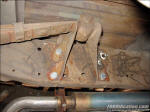|
How can
I lower my '67-'72 pickup?
For the back end, there are several options.
-
You can
have the rear springs professional de-arched (NEVER heat the
springs!), but this will probably require relocating the shackles and
spring hangers.
-
You can flip the rearend over which will place the
spring pads on the bottom of the rearend housing, lowering the truck
about 5 inches. However, it will probably be necessary to add a C-notch in the
frame to prevent the rearend housing from hitting the frame under
extreme suspension travel.
-
Another
way of gaining 1/2" to 1" drop is by removing the helper spring, the
thickest spring at the bottom of the spring pack. Keep in mind you
will lose payload capacity.
-
 You can
also
cut the factory rivets from the front bracket on the rear spring, flip
it over, and bolt it back down (requires drilling some new holes)
which will lower it 4-5 inches. When done, there is no change in ride
quality, though the axle bumpstops are getting close to hitting the frame during
suspension travel. The only other thing you might have to watch for is
altering the pinion angle, but this will also change by doing an axle
over. You might be OK, you might not. You will need to check your
pinion angle after you flip the hanger, and if the pinion angle has
been altered too much, it can be easily corrected by using angled
shims between the leaf spring and the perches on the rearend
housing. These can be obtained from an aftermarket source such as Jegs or Summit Racing. You can
also
cut the factory rivets from the front bracket on the rear spring, flip
it over, and bolt it back down (requires drilling some new holes)
which will lower it 4-5 inches. When done, there is no change in ride
quality, though the axle bumpstops are getting close to hitting the frame during
suspension travel. The only other thing you might have to watch for is
altering the pinion angle, but this will also change by doing an axle
over. You might be OK, you might not. You will need to check your
pinion angle after you flip the hanger, and if the pinion angle has
been altered too much, it can be easily corrected by using angled
shims between the leaf spring and the perches on the rearend
housing. These can be obtained from an aftermarket source such as Jegs or Summit Racing.
Depending
on the amount of drop in the back end, be sure to watch the bed lip up
inside the wheelwell for tire rubbing. If lowered too far, it can cut
into the tire's tread.
For the front, you can cut the front springs a bit, but
don't get carried away, as this will the affect the camber, which can
only be adjusted by a specialty shop by actually bending the I-beam.
Cut 1/2 a coil per side at a minimum to a maximum of 2 coils. Why?
Well, the design of the Ford I-beam suspension system means the I-beam
rotates around the beam's pivot point. As the beam travels up and
down, the camber changes dramatically. Cutting the spring will cause
the tops of the front tires to lean inwards, affecting steering
control. Moderation is the key here.
Another option is to use lowering springs...either
standard or progressive-rate. I've been told that the standard
lowering springs tend to have a harsher ride than the progressive-rate
springs.
The PROPER way to lower a front end is by using
aftermarket drop beams. AIM and DJM both make drop beams to replace
the standard Ford I-beams and both also sell the necessary parts to
lower the rear end. If you want wider wheels and disc brakes, go with
the DJM beams, as these are 1-1/2" shorter in length. AIM has beams
for the F100 and the F250/F350 trucks.
A steering dampener is recommended to reduce the bump-steer effect.
If money is no object and this is strictly a cruiser, another option
is to install the Mustang II IFS. You can buy this in kit form from
several vendors and have an almost limitless set of options as to drop
amounts, spring rates, bolt patterns, etc. |